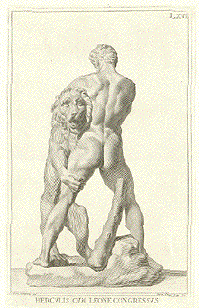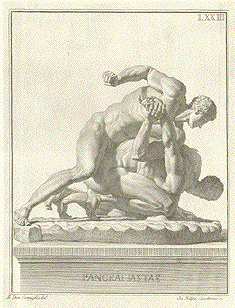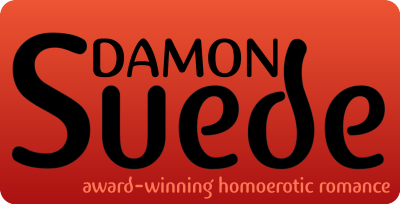Fictional Friction
by Damon Suede
All stories require friction. It’s the core of every character, every plot, every spectacle… Even the sweetest, softest saga involves heat generated between opposing forces rubbing together and changed thereby.
Friction occurs whenever two separate things or people or ideas push against each other. Friction energizes us and gets our attention. Characters, situations, and ideas interest us because of the conflict between what we believe and what we learn from encountering unexpected stimuli. Too extreme a disparity produces discomfort, but the right balance of surprise and expectation can be delicious. Friction is active. Friction is primitive. Friction is physical. Friction is sensory and sensual.
Friction is the reason sex feels good.
 Now… writers often hear about the
necessity of conflict.
After all, struggle both internal and external remains the root of
all drama. Unfortunately in romance writing, obsessing about
conflict can lead to monotonous, silly choices. The word conflict
gets authors into all sorts of trouble. Have you ever read a story
which forces lovers to bicker incessantly or deploys violence as a
flashy garnish? Often these books take “conflict” to mean literal
combat. In dramatic terms, fighting is the most literal and least
interesting form of conflict. This is the kind of porno-logic we
learn from the worst of
Now… writers often hear about the
necessity of conflict.
After all, struggle both internal and external remains the root of
all drama. Unfortunately in romance writing, obsessing about
conflict can lead to monotonous, silly choices. The word conflict
gets authors into all sorts of trouble. Have you ever read a story
which forces lovers to bicker incessantly or deploys violence as a
flashy garnish? Often these books take “conflict” to mean literal
combat. In dramatic terms, fighting is the most literal and least
interesting form of conflict. This is the kind of porno-logic we
learn from the worst of
Tension actually offers safer verbal turf for writers, except tension can devolve into stasis. Finding drama by hunting for “tension” sometimes leads to characters locked in disagreement or frozen situations in a kind of blank plateau that is anything but entertaining or romantic. Overreliance on tension can generate a strange paralysis that is neither engaging nor interesting. Have you ever gotten frustrated with characters stuck in a ruts, unable to communicate and unwilling to change? Feisty protagonists have a hard time battling restrictions if they are so neurotic they can’t take a single step. Goodbye romance, hello naptime. Characters must grow, events must have meaningful impact, and Happy Endings should be anything but tense.
Readers seek out interesting friction and writers thrive on it. As E.M. Forster once observed, "’The king died and then the queen died’ is a story. ‘The king died and then the queen died of grief’" is a plot.” I’d argue that the element that separates these two sentences is friction. In the second sentence, “grief” alters the Queen’s stasis via emotional abrasion… Whether by internal distress or external failure, the friction between her past and present literally scours this royal widow until nothing but death is left to her. Friction creates Forster’s much-vaunted plot.
Friction produces pearls and tsunamis; the bit of grit that itches the oyster can be every bit as dramatic as a tectonic shift causing a tidal wave. Unlike the potentially mindless “conflict” or frozen “tension,” friction can be as small as a grain of sand or as literally catastrophic as the earth moving.
So, where’s the rub?
 Romance,
more than any other genre, traces and retraces the issues of
connection between
separated elements, the tension created by division, the mortal
conflict between irreconcilable beliefs, desires, or temperaments.
Conflict ceases, tension releases, but romance’s ubiquitous Happy
Ending does not end the friction as much as allow it to burst into beautiful flame.
Romance,
more than any other genre, traces and retraces the issues of
connection between
separated elements, the tension created by division, the mortal
conflict between irreconcilable beliefs, desires, or temperaments.
Conflict ceases, tension releases, but romance’s ubiquitous Happy
Ending does not end the friction as much as allow it to burst into beautiful flame.
Friction. Tension. Conflict. Notice any overlap? They are all about the unique relationship between two or more things. Even internal conflict, individual tension, mental friction express a line stretched between different ideas or emotions. That connection can only be maintained as long as the surfaces stay close enough to touch without being combined. Like romance, friction generates energy through proximity and separation, connecting distinct participants and then bringing them together in heated exchanges.
Whether I’m writing a sex scene, a tender disclosure, or an internal monologue, I always start from the point of friction. In each moment, I look for the points of contact where the differences rub together and generate the most warmth and interest. By finding the friction, I can get at the spark of the scene and nurture it. If I manage to do my job properly, that glimmer will light something in my readers as well. It is that distinctive heat that characterizes romance fiction for me. Worlds colliding, opposites attracting, sparks flying, the loin and the limb…
Friction requires action. As a model for writers, romantic friction works on another level too: friction cannot happen without motion and relationship between two participants. Frankly, friction in fiction operates exactly as it does in intimacy… as a shifting dynamic interaction of differing things, as rough, soft, fast, slow, cruel, gentle as necessary… but never inert. As such, friction offers romance writers a rubric to draft and revise any scene… Find the points of contact that make things happen. Instead of manufacturing conflict or worrying about tension, see if you can identify sources of friction, the relationship and distinctions that evoke dynamic events, internal or external.
Friction generates heat! Do you ever worry about sexiness, or subtlety or specificity? Investigate the power sources in your projects. In concrete terms heat marks the resistance between molecules moving at different speeds as they skid against each other. What we think of as warmth is caused when those fast-moving molecules skid against slower (cooler) molecules. Every energy source we use harvests the force of resistance, from windmills to combustion engines. Harnessing friction gives us the power to change and direct our writing. Friction can and should inform dialogue, thought, settings, events, and physical intimacy.
 Friction causes change. By definition, friction
wears away at surfaces, so in order to maintain the abrasion between
characters or ideas, new grit and new pressure must be introduced.
Stakes must escalate or the heat generated will peter out.
Trace the ways friction
transforms each moment. Again, focus on friction serves us well
as we identify potential escalations and their relative impact.
Change is what makes situations interesting, keeps us reading and
prevents genre from becoming generic. Understanding and directing
friction allows writers to take risks and challenge expectations.
Friction causes change. By definition, friction
wears away at surfaces, so in order to maintain the abrasion between
characters or ideas, new grit and new pressure must be introduced.
Stakes must escalate or the heat generated will peter out.
Trace the ways friction
transforms each moment. Again, focus on friction serves us well
as we identify potential escalations and their relative impact.
Change is what makes situations interesting, keeps us reading and
prevents genre from becoming generic. Understanding and directing
friction allows writers to take risks and challenge expectations.
Friction produces fiction. We embrace ideas that spark our imaginations. We cherish characters whose potency ignites our passions. We remember books that touch us the right way.
And there’s the rub.
Copyright 2010. Damon Suede. All Rights Reserved

Originally published in the Pot of Gold (#9, Q3,
2011), the
newsletter of the
Rainbow Romance Writers chapter of the Romance Writers of America
If you wish to republish this article, just drop me a line.

